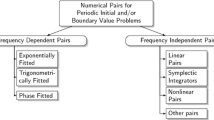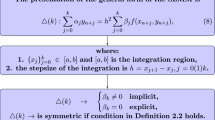Abstract
In a previous paper, some multistep cosine methods which integrate exactly the linear and stiff part of a second-order differential equation have been introduced and its convergence has been analysed under assumptions of regularity. In this paper, we characterize when this type of methods are symmetric and give a detailed analysis which allows to prove that these symmetric methods behave very advantageously with respect to the conservation of invariants when a Hamiltonian wave equation subject to periodic boundary conditions is integrated. In this way we prove that these methods are really competitive since they are explicit, stable and qualitatively correct for this type of equations.



Similar content being viewed by others
References
Bridges, T.J.: Multi-symplectic structures and wave propagation. Math. Proc. Camb. Philos. Soc. 121, 141–190 (1997)
Calvo, M.P., Palencia, C.: A class of explicit multistep exponential integrators for semilinear problems. Numer. Math. 102, 367–381 (2006)
Cano, B.: Integración numérica de órbitas periódicas con métodos multipaso. Phd tesis, Universidad de Valladolid (1996)
Cano, B.: Conserved quantities of some Hamiltonian wave equations after full discretization. Numer. Math. 103, 197–223 (2006)
Cano, B., Moreta, M.J.: Multistep cosine methods for second-order partial differential systems. IMA J. Numer. Anal. 30, 431–461 (2010)
Cano, B., Sanz-Serna, J.M.: Error growth in the numerical integration of periodic orbits by multistep methods, with application to reversible systems. IMA J. Numer. Anal. 18, 57–75 (1998)
Cohen, D., Hairer, E., Lubich, C.: Numerical energy conservation for multi-frequency oscillatory differential equations. BIT Numer. Math. 45, 287–305 (2005)
Cohen, D., Hairer, E., Lubich, C.: Conservation of energy, momentum and actions in numerical discretizations of non-linear wave equations. Numer. Math. 110, 113–143 (2008)
Cox, S.M., Matthews, P.C.: Exponential time differencing for stiff systems. J. Comput. Phys. 176, 430–455 (2002)
Hairer, E., Lubich, C.: Symmetric multistep methods over long times. Numer. Math. 97, 699–723 (2004)
Hairer, E., Nørsett, S., Wanner, G.: Solving Ordinary Differential Equations I, 2nd edn. Springer, Berlin (2000)
Hairer, E., Lubich, C., Wanner, G.: Geometric numerical integration. In: Structure-Preserving Algorithms for Ordinary Differential Equations, 2nd edn. Springer, Berlin (2006)
Hochbruch, M., Lubich, C.: A Gautschi-type method for oscillatory second-order differential equations. Numer. Math. 83, 403–426 (1999)
Hochbruck, M., Ostermann, A.: Explicit exponential Runge-Kutta methods for semilinear parabolic problems. SIAM J. Numer. Anal. 43, 1069–1090 (2005)
Hochbruck, M., Ostermann, A.: Exponential Runge-Kutta methods for parabolic problems. Appl. Numer. Math. 53, 323–339 (2005)
Oliver, M., West, M., Wulff, C.: Approximate momentum conservation for spatial semidiscretization of semilinear wave equations. Numer. Math. 97, 493–535 (2004)
Reich, S.: Multi-symplectic Runge-Kutta collocation methods for Hamiltonian wave equations. J. Comput. Phys. 157, 473–499 (2000)
Sneddon, I.: Fourier Transforms. Dover, New York (1995)
Stetter, H.J.: Analysis of Discretization Methods for Ordinary Differential Equations. Springer, Berlin (1973)
Stoffer, D.: On reversible and canonical integration methods. Research Report No. 88-05, Eidgenössische Technische Hochschule, Zürich (1988)
Tadmor, E.: The exponential accuracy of Fourier and Chebyshev differencing methods. SIAM J. Numer. Anal. 23, 1–10 (1986)
Author information
Authors and Affiliations
Corresponding author
Additional information
Communicated by Christian Lubich.
This research was supported by MTM 2011-23417.
Appendix
Appendix
1.1 A.1 Proof of Remark 5.1
Let us denote by \(\mathcal{F}(w(t,x))\) the infinite-dimensional vector whose components are the exact Fourier coefficients of w(t,x) for any real function w(t,x). Let us also denote by PR N the corresponding centered projection of N components. We have that

Then, \(\operatorname{Re} [N F_{N}^{-1} S \mathit{PR}_{N} [\mathcal{F} (u(t,x))] ]\) satisfies

As we are integrating system (5.6), the space truncation error δ N (t) will be that which satisfies

with u(t,x) the solution of (5.1) or (5.2). As it was already justified in [4],

where TR N,12(t,s) is the upright \((\frac{N}{2} \times\frac{N}{2})\) submatrix of TR N (t,s) in (5.7).
Notice that, from (A.1) and (A.2),

from what, bounding in the Euclidean norm,
where d=1 for the nonlinear wave equation and d=2 for the beam equation. Here we have used that \(\|N F_{N}^{-1} S\|=\sqrt{N}\), that for a holomorphic and periodic function in a complex band each of the approximated Fourier coefficients through the discrete Fourier transform differ from the exact one in \(O(e^{-\frac{\pi\beta N}{b-a}})\) [21], the fact that the functions u(t,x) and \(\hat{V}'(u(t,x))\) satisfy the hypotheses of regularity (HR1) and (HR2), and that ∥D N ∥=N d. Notice that the implicit constant in the residue is independent of N and t for t 0≤t≤t 0+T.
Because of (A.3), hypotheses of regularity (HR1)–(HR2)–(HR3) and the bound (A.5), for big enough N, we do have the bound \(|Z_{N,l+N/2+1}(t)|=O(e^{-\frac{2 \pi|l| \beta}{b-a}})\) for −N/2≤l≤N/2−1, where the implicit constant in Landau notation is independent of t for t 0≤t≤t 0+T. From that, in |Im (z)|≤β′, \(|\operatorname{Re} [\sum_{l=-N/2}^{N/2-1} Z_{N,l+N/2+1}(t)\* e^{2 \pi i l \frac{z-a}{b-a}} ]|\) will be O(1) and in the same domain, \(|\frac{d}{dz} \operatorname{Re} [\sum_{l=-N/2}^{N/2-1} Z_{N,l+N/2+1}(t)\* e^{2 \pi i l \frac{z-a}{b-a}} ]|\) will be O(N). Then,

for some constant C as stated.
1.2 A.2 Proof of Lemma 5.1
Let us first prove the following result.
Lemma A.1
For any real analytic periodic function w, which can be extended to a holomorphic function in a band \(|\operatorname{Im}(z)|\le\beta\), for any natural number r,
where the residue is measured in the Euclidean norm, \(\hat{W}_{2rd,N}\) denotes the vector of nodal values of \(D_{s}^{2rd} w\) with D s the first derivative in space and where d takes the value 1 for wave equation and 2 for beam equation.
Proof
Notice that, because of the definition of Ω N and similar arguments to those just used for bounding δ N in (A.5),

□
Now, by using (A.3),

Now, because of hypotheses (HR1), (HR2) and Lemma A.1, the first term in the previous expression is uniformly bounded on t 0≤t≤t 0+T and for big enough N. On the other hand, considering the definition of C N (t) in (5.7) and that of δ N in (A.2), the bound \(O(N^{1+2d(1+r)}e^{-\frac {\pi\beta N}{b-a}})\) can be obtained for the third term in the same way that bound (A.5) was obtained for δ N . Finally, using also hypothesis (HR3) and the definition of the transition matrix, the second term will also be bounded by \(O(t N^{1+2d(1+r)} e^{-\frac{\pi\beta N}{b-a}})\), which is also uniformly bounded for t 0≤t≤t 0+T and big enough N, from what the result follows.
Now, we check that for each natural r,l, \(\varOmega_{N}^{2r} \hat {V}^{(l+1)}(U_{N}(t))\) is also uniformly bounded. We take into account that \(\hat{V}^{(l+1)}\) is Lipschitz, with Lipschitz constant L l , so
Now, because of (HR1) and Lemma A.1, the first term is uniformly bounded as we want, and the second term, by using (A.3) and (A.5), is bounded by \(O( t N^{1+2d(1+r)} e^{-\frac{\pi\beta N}{b-a}})\), which is again uniformly bounded for t 0≤t≤t 0+T and big enough N.
1.3 A.3 Proof of Theorem 5.2
Notice that the fact that

implies that

which would correspond to the smooth part of the substitution of (5.8) in (A.6).
Now, proceeding in the same way as in the proof of Theorem 4.2 in Sect. 4 but substituting M by 2p, there exists a formal modified energy

such that its truncation at the O(h 2p) term satisfies

Besides, the functions \(H_{N,j}(\tilde{U}_{N}(t), \dot{\tilde{U}}_{N}(t))\) (p≤j≤2p−1) do depend on expressions of the form \((D^{l} \tilde{U}_{N}(t))^{T} \varOmega_{N}^{2r} D^{m} \tilde{U}_{N}(t)\) with l+2r+m=j+2. Using (HR1)–(HR2)–(HR3), (A.3) and the bound (A.5), it follows that for big enough N, \(\varOmega_{N}^{2r} D^{s} U_{N} (t)\) (2r+s≤2p+1) is uniformly bounded for t 0≤t≤t 0+T. On the other hand, using also (HR4), (5.10) and (A.3), \(E_{N,j1}^{(s)}(t)\) (p≤j≤2p−1) will behave like O(t) for big enough N and t 0≤t≤t 0+T. Therefore, for r,m such that p+2≤2r+m≤2p+1,
From here, whenever t=O(h −p), \(((b-a)/N)H_{N,j}(\tilde{U}_{N}(t),\dot {\tilde{U}}_{N}(t))\) will be uniformly bounded. Then, from (A.9),
And using (A.8),

Now, because of Corollary 8, E N,li vanishes for l=p,p+1 and grows like (t n −t 0)l−p−2 for p+2≤l≤2p−1 (whenever p>2). On the other hand, \(\nabla\tilde{H}_{N}\) and ∇H N,j are bounded when evaluated at \({\mathcal{M}}_{\lambda,N,n}=\lambda(U_{N,n},V_{N,n})+ (1-\lambda)(\tilde{U}_{N}(t_{n}), \tilde{V}_{N}(t_{n}))\), due to (A.10) for m=0,1. From that, for t n −t 0=O(h −p),

where the last summation does not turn up for p=2. For p≥4, the terms in the last summation will be O(h p+2) for l=p+2 (where the implicit constant does not depend on t n ) and O(h p) for l>p+2, where the same remark applies when \(t_{n}-t_{0}=O(h^{\frac{p-l}{l-p-2}})=O(h^{-1-\frac{2}{l-p-2}})\), which takes its minimum at l=2p−1, where it is \(t_{n}-t_{0}=O(h^{-\frac{p-1}{p-3}})\). From this,
where the implicit constant does not depend on t n when \(t_{n}-t_{0}=\min(T, O(h^{-\frac{p-1}{p-3}}))\) if p≥4, and t n −t 0=min(T,O(h −2)) if p=2.
Finally, applying (A.8) again and then (5.9),

1.4 A.4 Proof of Theorem 5.3
Notice first that Theorem 5.1 is also equivalent to
Then, following a similar proof to that of Theorem 5.2 and the steps in [10] for the boundedness in time of the error in a quadratic invariant, where the matrix which defines it is skew-symmetric, there exists a formal modified momentum
such that its truncation at the O(h 2p)-term satisfies
Besides, the functions \(M_{N,j}(\tilde{U}_{N},\dot{\tilde{U}}_{N})\) are equivalent to a sum of expressions of the form
In the same way than in the proof of Theorem 5.2 and taking also Lemma 5.1 into account, whenever t n −t 0=O(h −p), \(\frac{b-a}{N} M_{N,j}(\tilde{U}_{N}(t_{n}),\tilde{V}_{N}(t_{n}))\) are uniformly bounded for big enough N. The rest of the proof is exactly the same as that of Theorem 5.2, except for adding the term \(O(t_{n} C_{N,\beta'}(t_{n}) e^{-\frac{\pi\beta' N}{b-a}})\) in (A.11) and consecutively.
Rights and permissions
About this article
Cite this article
Cano, B. Conservation of invariants by symmetric multistep cosine methods for second-order partial differential equations. Bit Numer Math 53, 29–56 (2013). https://doi.org/10.1007/s10543-012-0393-1
Received:
Accepted:
Published:
Issue Date:
DOI: https://doi.org/10.1007/s10543-012-0393-1
Keywords
- Exponential integrators
- Multistep methods
- Second-order partial differential equations
- Symmetric methods
- Conservation of invariants




